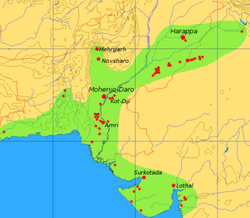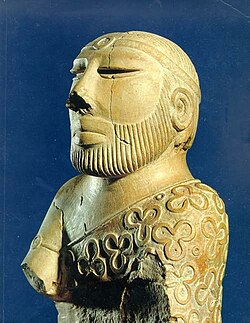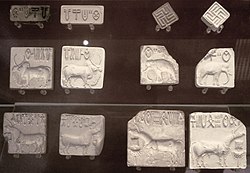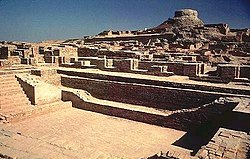Indus Valley civilization




The Indus Valley civilization or the Harrapan civilization (3300–1300 BC; mature period 2700–1700 BC) was a Bronze Age civilization.[1] It is among the four oldest civilisations in the world and also the earliest known urban culture of South Asia.[2][3] It was discovered by archaeologists in the 1880s. It developed along the Indus and the Ghaggar-Hakra rivers. It is one of the world’s three earliest civilizations, along with Mesopotamia and Ancient Egypt.[4]
The Indus Valley civilization covered a large area – from most of modern Pakistan to small parts of western India. The first city to be discovered by excavation (digging up) was Harappa in Punjab, Pakistan and so this civilization is also called the 'Harappan Civilization'.
The civilization started during the Bronze Age and the height of its development was between 2500 BC and 1500 BC. Including the civilizations directly before and after, it may have lasted from the 3rd to the 14th century BC.[5][6] Its two large cities are Harappa and Mohenjo-daro in Pakistan’s Punjab and Sindh provinces. The ruins of Mohenjo-daro were designated a UNESCO World Heritage site in 1980.[7]
They were good builders. The ruins of the site shows skillful design. Their buildings had two or sometimes more stories. The bathrooms were attached to the rooms. One of the unique features of the city was its elaborate drainage system. A brick-lined drainage channel flowed alongside every street. Removable bricks were placed at regular intervals for easy cleaning and inspection.
The Harappan traders used seals on the knots of the sacks to be transported to make sure that they were not opened during the journey. Nobody knows how to read their writing system.
In 1842 Charles Masson wrote a book that mentioned the sites of Indus Valley Civilisation.[8] Few people paid attention. Later, in 1921/22, John Marshall organised the first archaeological dig at Harappa.[9]
References
[change | change source]- ↑ "Pakistan", The World Factbook, Central Intelligence Agency, 2024-01-02, retrieved 2024-01-08
- ↑ "The World's Oldest Civilizations". WorldAtlas. 2023-02-07. Retrieved 2024-01-08.
- ↑ "Indus civilization | History, Location, Map, Artifacts, Language, & Facts | Britannica". www.britannica.com. 2023-12-29. Retrieved 2024-01-08.
- ↑ "Indus civilization | History, Location, Map, Artifacts, Language, & Facts | Britannica". www.britannica.com. 2023-10-11. Retrieved 2023-12-01.
- ↑ Allchin, Bridget 1997. Origins of a Civilization: the prehistory and early archaeology of South Asia. New York: Viking.
- ↑ Kenoyer, Jonathan Mark 1998. Ancient cities of the Indus Valley civilisation. Oxford University Press. ISBN 0-19-577940-1
- ↑ "Indus civilization | History, Location, Map, Artifacts, Language, & Facts | Britannica". www.britannica.com. 2023-10-11. Retrieved 2023-12-01.
- ↑ Masson, Charles 1842. Chapter 2: Haripah, in Narrative of various journeys in Balochistan, Afghanistan and the Panjab; including a residence in those countries from 1826 to 1838. London: Richard Bentley, p. 472.
- ↑ Marshall, John (ed) 1931. Mohenjo-Daro and the Indus Civilization. Asian Educational Services. ISBN 978-81-206-1179-5
